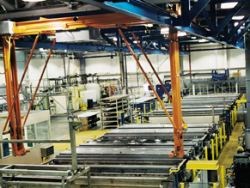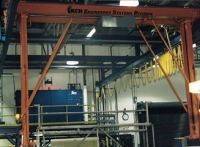Adding Process Control Cuts Etch Time by Half
Boeing needed to update its finishing processes in order to stay competitive in the aerospace industry. By adding a new line with a programmable logic controller, it was able to do just that...
Since the 1970s, Boeing, St. Louis, MO (originally McDonnell Douglas) has been manufacturing composite structures for its high-performance aircraft. A composite is defined as a complex material in which two or more distinct structurally complementary substances combine to produce structural or functional properties not present in any individual component. Although the major focus of structural design in early development was on strength, now aircraft structural designers must also deal with fail safety, fatigue, corrosion, maintenance, inspection and producibility. Much of this is accomplished using advanced methods using composite assembly technologies.
Manufacturing Composite Components
Composite parts produced at the St. Louis Composite Center are aluminum to aluminum; aluminum to titanium; and aluminum and titanium to graphite bonded structures. The Center prepares large titanium details (details refer to any piece that makes up part of a larger structure) for the F/A-18 inboard wingskins along with aluminum skins and aluminum details for bonding control surface structures. Large titanium details are bonded to built-up layers of graphite epoxy to make the wingskins while the aluminum skins and details are used to build trailing edge and leading edge flaps. Most of the bonding is done with adhesives. A layer of adhesive is applied to the bonding surfaces; the parts are then vacuum bagged and processed under heat and pressure in an autoclave.
The Composite Center recently stepped up these processes to a new level with a new state-of-the-art Chemical Processing Facility. The Composite Center was originally equipped with a standard manually operated hoist line, considered state-of-the-art when it was built in the early 1970s. The old system consisted of process and rinse tanks, two manual hoists, hand timers and some antiquated process controls. This line was in a satellite building and fed the main Composite Center with clean and primed details. In the mid 1990s, Boeing realized that to remain competitive in the aerospace structure business, it needed to consolidate bonding processes under one roof to cut costs and limit damage during transport, hence the new facility.
The Chemical Processing Facility was designed to fully consolidate the composite operations into one building. The Equipment and Process Engineering group in St. Louis released a detailed equipment specification to several capable companies. For the chemical processing line, The Engineering Group specified a single fully automated hoist line spanning more than 160 ft, automatic tank covers, filtering units on all solution tanks, integrated exhaust, PC-based control package and a new flow-through primer paint line and oven. After competitive bids were reviewed, KCH Services was awarded the order.
Process Set Up
At each end of the chemical processing line are hydraulic lift tables that are used as load/unload stations. Details are hung on either stainless or polypropylene racks, depending on the process. Each part rack loads into a roll-around cart and is then addressed to the system. The racks are rolled into one of four load stations. Once the cart is loaded, the operator initiates the process cycle by locking down the cart in the load station. The locking mechanisms are also proximity sensors that relay back to the controller only when the cart is fully locked and ready for processing. If a cart is not locked from both ends of the station, the controller will not process. The process cycle is then initiated through the control system by selecting one of the programs stored in the controller. As many as four racks can be run simultaneously, depending on the position and destination of the rack.
The line actually consists of two processes: titanium clean and etch; and aluminum clean and etch. Ninety-eight percent of all parts, some already bonded, are run through the cleaning lines. Titanium parts are first etched with a slurry of aluminum oxide and water. Next, these parts are put through an alkaline cleaner, immersion rinse, spray rinse, Pasa-jel or acid etch (proprietary process), immersion rinse, spray rinse, dry, inspect, spray with bonding primer, cure, wrap and release for assembly.
Aluminum parts got through a hot alkaline cleaner, immersion rinse, spray rinse, sulfuric dichromate etch, immersion rinse, spray rinse, dry, inspect, spray with bonding primer, cure, wrap and release. To reduce costs, a single hoist is used and all tanks are set up in-line accessible from a natural break between the two processes.
Chemical Control
The system does not control process chemistry by making chemical additions. However, the control system does monitor and collect data such as temperature, solution level, time in bath and conductivity, which are also important to the lab analysis of the bath, which is monitored daily by Boeing's lab personnel who make all recommendations for chemical additions.
Control of the Controls
Line control is only part of the improvement Boeing has made. The hoist is equipped with a laser distance meter for precise rack drops in assigned tanks. Consequently, the tanks are smaller and yet still do the same work. Because of the smaller tanks, disk filtration has been incorporated into all process baths to remove impurities and reduce the number of tank shutdowns required for cleaning. With the previous system, tank clean outs were common. Some process tanks required cleaning and recharging every 3 to 4 months.
The PC is used as the operator interface to communicate directly to a PLC. The PLC controls all functions and monitors all 4-20 mA inputs relayed from status devices such as pressure transducers, which provide information about the filtration units on each process solution. This allows for precise monitoring of pressure through the filter vessels, helping Boeing determine if filter media should be cleaned or changed if there are pump or flow problems. Other monitoring equipment includes flow meters, conductivity sensors and temperature sensors. Built-in alarms warn against line irregularities, if they occur. The PLC acts as a central processor for gathering data and then issues instructions to the hoist lift and tank line components.
The operator interfaces with the system via a Pentium-powered PC mounted in the operator control station located close to the load station. Operators, however, are not allowed access to make program changes.
The system also contains random loading capability. This software allows for loading and unloading of work to and from queue, so that the system can be run for extended periods without an operator present. When racked parts are presented to process tanks, the tank covers open automatically, and the exhaust increases. When the parts are immersed in solution, the covers close. The exhaust dampers close down approximately two-thirds of the way, drastically reducing the amount of exhaust and subsequent energy consumption.
The previous manual systems had exhausted open tanks that drew large amounts of air from a cross section of the solution surface. To cut down the total volume of air that is exhausted, tank covers are electronically interlocked to the dampers built into the outlet of the exhaust hoods. This design reduces the exhaust flow rate as the covers close and increases the exhaust flow rate when the covers are open. A tremendous saving of exhaust and subsequent makeup air is realized using these automated tank covers.
System Archives Data
This system is capable of storing and processing hundreds of sequencing programs if required; although, Boeing only uses 6 at present. Programming is accomplished using operational software for hoist and tank line control/supervision. The software is a WindowsNT based prompting system that allows individuals with limited computer skills and programming knowledge the ability to navigate through the system with relative ease. A graphic representation of the line helps the operator recognize line problems and helps to quickly eliminate the line faults, substantially reducing line downtime.
The control system captures data as parts are processed. Boeing is able to archive all data for future retrieval, opening the door for implementation of statistical process control in this area.
Modem Support
Another key element of the system is modem support. The control package is connected to a modem that permits remote troubleshooting of the system virtually anytime or place. The supplier's technicians, hundreds of miles away, are allowed to access the system when requested by Boeing line operators or maintenance personnel in the event of problems in the process line, thereby becoming an “intelligent” terminal for Boeing.
Boeing only uses this feature periodically and mainly used it during start-up when it found errors in the original programming. Additional features have been added to the software that cleared up any “bugs,” and the system is now working cleanly.
Paint Booth
In conjunction with Fluid Air Products, St. Louis, MO, the main supplier provided a prime paint booth and ancillary line. Parts flow from the etching line into a spray booth where they are primed. Sealed doors are opened and parts enter a flash tunnel where VOCs are flashed off. When the flash off is complete, the inside doors of the drying oven are actuated and parts go through a flow-through curing oven. At no point in this process are primed parts exposed to unfiltered air, which might compromise their cleanliness and bonding integrity.
Processing is now done on the first shift and primer paint operations are completed on the second shift, eliminating the overlap of both jobs.
Are further improvements or additions planned? Boeing can only point out that much of this depends on the growth of the defense industry aircraft market. In the meantime, Boeing has moved into the realm of automated process control and is experiencing its many benefits.
Because of the new automated processing, Boeing has been able to accomplish its processing work in a single shift rather than the double or triple shifts sometimes required with the previous manual system. This has allowed Boeing to reduce energy costs by more than $60,000 annually. With the use of covered tanks, positive draft air handling and a mist eliminator system, Boeing has also reduced exhaust emissions by approximately 75% in addition to satisfying all EPA requirements.
Not only is Boeing satisfying environmental requirements and saving money, updating its finishing line and adding process control has prepared it to remain competitive in the airline and aerospace markets.
To learn more visit KCH Services, Inc..
Related Content
Wastewater Contamination Removal System
Each environmentally beneficial system treats the wastewater stream at a fraction of the cost of larger, more complex industrial systems.
Read MoreAerospace Conductive Coating Provides Adhesion, Fluid Resistance
Conductive coating (CM0485115) provides a high-conductivity solution for dissipating static on aluminum and composite aircraft.
Read MoreAnodizing for Bonding Applications in Aerospace
Anodizing for pre-prep bonding bridges the gap between metallic and composite worlds, as it provides a superior surface in many applications on aluminum components for bonding to these composites.
Read MoreAdvancing Aerospace Connectors
OEMs looking to optimize aircraft performance and range are turning to composites and plastics, which require specific finishing treatments.
Read MoreRead Next
Education Bringing Cleaning to Machining
Debuting new speakers and cleaning technology content during this half-day workshop co-located with IMTS 2024.
Read MoreDelivering Increased Benefits to Greenhouse Films
Baystar's Borstar technology is helping customers deliver better, more reliable production methods to greenhouse agriculture.
Read MoreEpisode 45: An Interview with Chandler Mancuso, MacDermid Envio Solutions
Chandler Mancuso, technical director with MacDermid Envio discusses updating your wastewater treatment system and implementing materials recycling solutions to increase efficiencies, control costs and reduce environmental impact.
Read More
















.jpg;maxWidth=300;quality=90)







